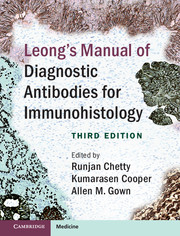Book contents
- Leong's Manual of Diagnostic Antibodies for ImmunohistologyThird Edition
- Leong's Manual of Diagnostic Antibodies for Immunohistology
- Copyright page
- Dedication
- Contents
- Contributors
- Preface to the first edition
- Preface to the second edition
- Preface to the third edition
- Note
- Introduction
- Section 1 Antibodies
- Book part
- References
Section 1 - Antibodies
Published online by Cambridge University Press: 27 October 2016
- Leong's Manual of Diagnostic Antibodies for ImmunohistologyThird Edition
- Leong's Manual of Diagnostic Antibodies for Immunohistology
- Copyright page
- Dedication
- Contents
- Contributors
- Preface to the first edition
- Preface to the second edition
- Preface to the third edition
- Note
- Introduction
- Section 1 Antibodies
- Book part
- References
Summary

- Type
- Chapter
- Information
- Publisher: Cambridge University PressPrint publication year: 2016



